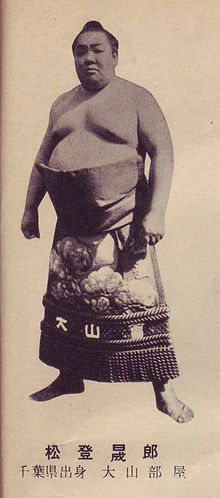Matsunobori Shigeo
| Matsunobori Shigeo | |
|---|---|
| 松登 晟郎 | |
 | |
| Personal information | |
| Born | Fukutarō Nagai 20 July 1924 Matsudo, Chiba, Japan |
| Died | 21 April 1986 (aged 61) |
| Height | 1.72 m (5 ft 7+1⁄2 in) |
| Weight | 154 kg (340 lb) |
| Career | |
| Stable | Ōyama |
| Record | 469–442–29 |
| Debut | January 1941 |
| Highest rank | Ōzeki (January 1956) |
| Retired | November 1961 |
| Elder name | Ōyama |
| Special Prizes | Outstanding Performance (2) Fighting Spirit (1) |
| Gold Stars | 2 (Haguroyama, Chiyonoyama) |
| * Up to date as of June 2020. | |
Matsunobori Shigeo (20 July 1924 – 21 April 1986) was a sumo wrestler from Matsudo Chiba, Japan. He fought for the now defunct Ōyama stable, joining in 1941. He reached the top makuuchi division in 1951 and made the second highest ōzeki rank (alongside Wakanohana) in 1956, after finishing as a runner-up to Kagamisato in the September 1955 tournament. He was an ōzeki for fifteen tournaments, although he lost the rank at the end of 1958. He retired in November 1961, and in his role as an elder of the Japan Sumo Association he became the head of Ōyama stable in January 1962 upon the death of his old stablemaster, ex-sekiwake Takanobori.[1] He produced one sekitori, the maegashira Daihi, who retired in 1983. Shortly after Ōyama's death in April 1986 the stable was wound up and its two remaining wrestlers retired.
Pre-modern top division record
[edit]- The New Year tournament began and the Spring tournament returned to Osaka in 1953.
| - | Spring Haru basho, Tokyo |
Summer Natsu basho, Tokyo |
Autumn Aki basho, Tokyo |
|||
|---|---|---|---|---|---|---|
| 1951 | East Jūryō #3 8–7 |
West Jūryō #1 11–4 |
East Maegashira #16 10–5 |
|||
| 1952 | East Maegashira #7 7–8 |
West Maegashira #8 8–7 |
East Maegashira #4 9–6 ★ |
|||
| Record given as wins–losses–absences Top division champion Top division runner-up Retired Lower divisions Non-participation Sanshō key: F=Fighting spirit; O=Outstanding performance; T=Technique Also shown: ★=Kinboshi; P=Playoff(s) |
||||||
| - | New Year Hatsu basho, Tokyo |
Spring Haru basho, Osaka |
Summer Natsu basho, Tokyo |
Autumn Aki basho, Tokyo | ||
|---|---|---|---|---|---|---|
| 1953 | East Komusubi #1 9–6 |
East Komusubi #1 6–9 |
East Maegashira #3 10–5 |
West Sekiwake #1 6–9 |
||
| 1954 | West Maegashira #2 11–4 F★ |
West Sekiwake #1 8–7 |
East Sekiwake #2 9–6 O |
East Sekiwake #2 9–6 |
||
| 1955 | West Sekiwake #2 8–7 |
West Sekiwake #2 11–4 |
East Sekiwake #1 8–7 |
East Sekiwake #1 13–2 O |
||
| 1956 | West Ōzeki #1 5–10 |
East Ōzeki #2 9–6 |
East Ōzeki #2 9–6 |
East Ōzeki #2 9–6 |
||
| Record given as wins–losses–absences Top division champion Top division runner-up Retired Lower divisions Non-participation Sanshō key: F=Fighting spirit; O=Outstanding performance; T=Technique Also shown: ★=Kinboshi; P=Playoff(s) |
||||||
Modern top division record
[edit]- Since the addition of the Kyushu tournament in 1957 and the Nagoya tournament in 1958, the yearly schedule has remained unchanged.
| Year | January Hatsu basho, Tokyo |
March Haru basho, Osaka |
May Natsu basho, Tokyo |
July Nagoya basho, Nagoya |
September Aki basho, Tokyo |
November Kyūshū basho, Fukuoka |
|---|---|---|---|---|---|---|
| 1957 | West Ōzeki #1 9–6 |
West Ōzeki #1 9–6 |
East Ōzeki #2 8–7 |
Not held | East Ōzeki #2 6–9 |
East Ōzeki #2 9–6 |
| 1958 | East Ōzeki #2 Sat out due to injury 0–0–15 |
West Ōzeki #1 6–9 |
West Ōzeki #2 8–7 |
West Ōzeki #2 5–10 |
West Ōzeki #2 1–5–9 |
West Ōzeki #2 6–9 |
| 1959 | West Sekiwake #1 3–12 |
West Maegashira #2 9–6 |
East Komusubi #1 6–9 |
East Maegashira #1 5–10 |
West Maegashira #5 6–9 |
East Maegashira #10 8–7 |
| 1960 | East Maegashira #7 7–8 |
West Maegashira #8 6–9 |
West Maegashira #11 7–8 |
West Maegashira #11 8–7 |
West Maegashira #6 7–8 |
West Maegashira #7 4–11 |
| 1961 | West Maegashira #15 10–5 |
East Maegashira #9 7–8 |
West Maegashira #9 8–7 |
West Maegashira #7 7–8 |
West Maegashira #6 5–10 |
East Maegashira #11 Retired 4–11 |
| Record given as wins–losses–absences Top division champion Top division runner-up Retired Lower divisions Non-participation Sanshō key: F=Fighting spirit; O=Outstanding performance; T=Technique Also shown: ★=Kinboshi; P=Playoff(s) |
||||||
See also
[edit]References
[edit]- ^ Gunning, John (February 2006). "Sekiwake Takanobori. "The Raiden of Shinshu"". Sumo Fan Magazine. Retrieved 11 May 2018.
- ^ "Matsunobori Shigeo Rikishi Information". Sumo Reference. Retrieved 18 October 2012.
